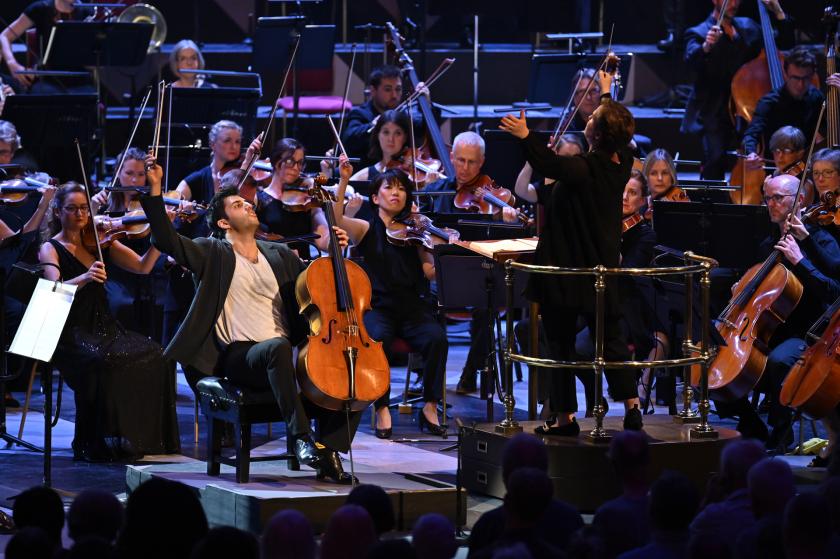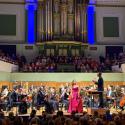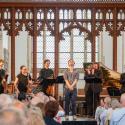Proper music tells stories just about itself, the stern pedagogues insist; it doesn’t (or anyway shouldn’t) paint descriptive pictures of places and people. Well, maybe not – but it was hard to banish all thoughts of geography, even of biography, at the Proms as the BBC Philharmonic under Eva Ollikainen travelled from Anna Thorvaldsdottir’s chthonic Iceland to Sibelius’s composite Italy-Finland by way of the intensely subjective journey embodied in Elgar’s Cello Concerto. Kian Soltani – Austrian-born with Iranian heritage, and something of a cross-cultural voyager himself – was the soloist in a polished and burnished account of the concerto, while the Finnish conductor forcefully, but elegantly, chased and rode the storm of her compatriot’s Second Symphony.
We began, though, in uncharted territory. The world premiere of Thorvaldsdottir’s ARCHORA came with a blurb that frankly befogged more than it clarified. The composer posits a dialogue between the world of “primordial energy” and “the idea of an omnipresent parallel realm... nowhere and everywhere at the same time". Don’t scoff just yet, though: I’ve travelled in Iceland and – without wanting to be too empirical about such things – the sense of a growling, flashing underworld a thin crust away from everyday experience can feel far from mystical amid the country's tectonic turbulence.
 Tuba and timpani (on three sites around the wide arc of the rear stage) rumbled and erupted ominously – volcanically? – before the violin found a tentative voice of its own. As the work kicked off, it was the emergence of matter from chaos in Haydn’s Creation that first came to mind. Textures thickened in strings and brass as Thorvaldsdottir coloured more and more of this primeval sonic landscape, with jolting bursts of infernal energy that didn’t sound too far distant from (say) the Mars that Prom-goers would have encountered the evening before in Holst’s Planets. Eerie, unsettling sul ponticello and con legno effects in the strings, and plaintive bird-like cries from the woodwinds, contributed to a fairly familiar modern Nordic scenography, but with a strong compositional grasp of the overall picture as well as deft precision in local colour. As the violins rose in melodic flight before that deep brass returned us to the earth’s molten flux, Thorvalddottir’s eerie domain proved well worth another visit. And its golden-gowned creator was on hand to take a bow (pictured above).
Tuba and timpani (on three sites around the wide arc of the rear stage) rumbled and erupted ominously – volcanically? – before the violin found a tentative voice of its own. As the work kicked off, it was the emergence of matter from chaos in Haydn’s Creation that first came to mind. Textures thickened in strings and brass as Thorvaldsdottir coloured more and more of this primeval sonic landscape, with jolting bursts of infernal energy that didn’t sound too far distant from (say) the Mars that Prom-goers would have encountered the evening before in Holst’s Planets. Eerie, unsettling sul ponticello and con legno effects in the strings, and plaintive bird-like cries from the woodwinds, contributed to a fairly familiar modern Nordic scenography, but with a strong compositional grasp of the overall picture as well as deft precision in local colour. As the violins rose in melodic flight before that deep brass returned us to the earth’s molten flux, Thorvalddottir’s eerie domain proved well worth another visit. And its golden-gowned creator was on hand to take a bow (pictured above).
Kian Soltani played the Elgar with loving attentiveness and meticulous technique that sometimes, I felt, stopped a little short of passion. Of course no one needs another Jacqueline du Pré tribute act, and you could hardly fault the cantabile warmth of his opening theme or the delicate balance that Ollikainen struck between cello and players. Soltani gave us transparency as much as intimacy, and the skittish, antic qualities of the scherzo stood out here. The young soloist achieved a mature, introspective reading short on lavish sentiment – a good thing for sure – but perhaps slightly lacking in expressive light and shade. Soltani’s well-controlled vibrato avoided extremes and he excelled in those restless, questing passages of the finale that precede the return of the core theme in all its yearning and elegiac glory.
 There’s no doubt about the beauty of his tone or the finesse of his touch, while Ollikainen proved a sensitive partner as she allowed the BBC Phil to showcase the fugitive, chamber music-like subtlety in much of Elgar’s orchestration. Soltani’s encore – the Ukrainian folksong “Lovely Minka”, in his own arrangement for cello and orchestra – proved very affecting and gorgeously played.
There’s no doubt about the beauty of his tone or the finesse of his touch, while Ollikainen proved a sensitive partner as she allowed the BBC Phil to showcase the fugitive, chamber music-like subtlety in much of Elgar’s orchestration. Soltani’s encore – the Ukrainian folksong “Lovely Minka”, in his own arrangement for cello and orchestra – proved very affecting and gorgeously played.
In Sibelius’s Second, Ollikainen displayed not just total strategic command of the score but a keen tactical attention to its sometimes mercurial shifts of direction and focus. You grasped the urgency of the dialogue between the lyrical, sun-dappled “Italian” aspects of the work (originally sketched in Rapallo and Rome) and the darker, earthbound and woodland, tonalities of the Finnish landscape that consitently inspired him. You also heard the toil and stress that must come before the heroic, hard-won reconciliation between these distant worlds. The BBC Phil horns – part of a thoroughly impressive brass section, crunchy and mellow by turns – and some sensuously warm woodwinds launched the springtime journey of the Allegretto opening. Here and throughout, Ollikainen effectively built up musical sentences into paragraphs, and paragraphs into chapters. She let the grand story of the symphony to unfold from its seemingly disconnected elements.
 At every step, she involved us at every step in this pilgrims progress (if that’s what it is) and, in the slow-building narrative of the Andante, made each mood count, from the pizzicato plod of the bass to the wistful, faraway brass. As the stonking, show-off themes of the third and fourth movements grew out of harmonic perplexity, and complexity, Ollikainen (pictured above) kept up a satisfying sense of foreboding and expectancy. Her spacious but never loose phrasing gave us plenty of doubt and suspense before the final triumph, with defly stippled tone colours and tempi that drew us deep into the drama. When it finally arrived, the anthemic climax struck with all the force of destiny.
At every step, she involved us at every step in this pilgrims progress (if that’s what it is) and, in the slow-building narrative of the Andante, made each mood count, from the pizzicato plod of the bass to the wistful, faraway brass. As the stonking, show-off themes of the third and fourth movements grew out of harmonic perplexity, and complexity, Ollikainen (pictured above) kept up a satisfying sense of foreboding and expectancy. Her spacious but never loose phrasing gave us plenty of doubt and suspense before the final triumph, with defly stippled tone colours and tempi that drew us deep into the drama. When it finally arrived, the anthemic climax struck with all the force of destiny.














Add comment